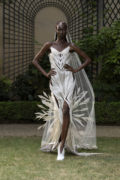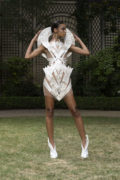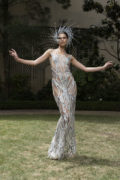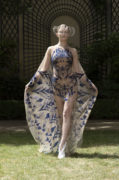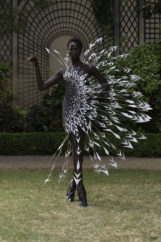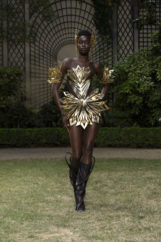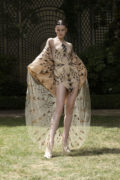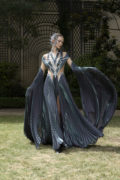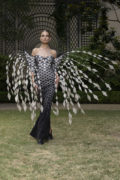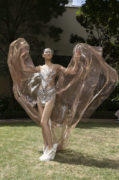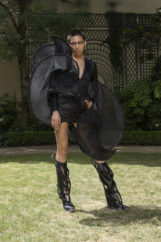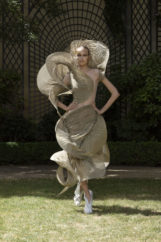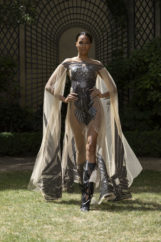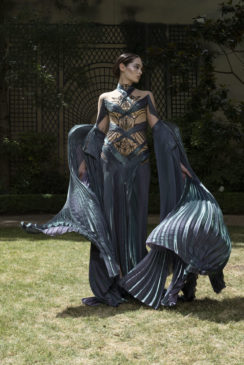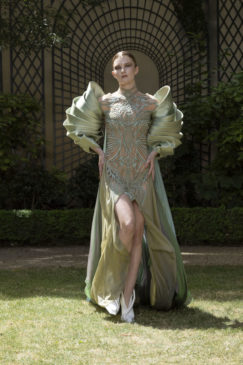Dear Shaded Viewers,
In a realm where many couture designers find inspiration in the past, Iris Van Herpen emerges as a true futurist, whisking us away this season with her bionic innovations seamlessly intertwined with her vision of aquatic architecture. Brace yourself for a journey beyond reality, where floating cities and a future yet to be grasped come alive.
Van Herpen’s creative odyssey commences with the profound ideas of Jacques Rougerie, the celebrated French Architect and Oceanographer aptly hailed as the ‘Architect of the Sea.’ Rougerie’s visionary work transcends the boundaries between scientific exploration and architectural ingenuity, illuminating the intricate relationship between our constructed environment and the vast oceans. Van Herpen, guided by his designs of underwater habitats and floating laboratories, delves fearlessly into the realm of aquatic urbanism, charting unexplored territories of creative expression.
Drawing inspiration from the groundbreaking ‘Oceanix,’ the world’s first floating city currently taking shape in South Korea, Van Herpen’s collection channels the spirit of transformative waterborne urbanism. Conceived by the visionary starchitect Bjarke Ingels, Oceanix stands as a testament to ingenuity, integrating principles of zero waste, circular systems, net-zero energy, and coastal habitat regeneration. It is this innovative spirit that echoes throughout Van Herpen’s collection, infusing each look with its own dynamic energy.
Vincent Callebaut’s trailblazing ocean architecture projects, such as ‘Lilypad’ and ‘Oceanscrapers,’ have also left an indelible mark on Van Herpen’s creative evolution. As an ardent advocate for sustainable living and environmental preservation, Callebaut’s visionary concepts harness renewable energy sources, offer habitats for our ever-growing population, and serve as catalysts for marine biodiversity and ecological regeneration. Van Herpen pays homage to Callebaut’s pioneering vision, seamlessly merging artistry and environmental consciousness within her designs.
This new generation of architects represents a radical shift in urban planning, presenting us with a blueprint for the resilient cities of the future. It is within this paradigm-shifting context that Van Herpen’s collection materializes, embodying the principles of parametric architecture renowned for its fluidity, fragmentation, and dynamic patterns. The designs pulsate, challenging our perception of form and movement.
Van Herpen explores aquatic urbanism, delving deep into the physiological, behavioral, and structural adaptations of biological organisms. Through meticulous craftsmanship, she blurs the lines between fashion and floating architecture, forging new couture techniques that seamlessly merge the two realms. Each look undergoes a digital modeling process before embracing the physical draping, a testament to Van Herpen’s unwavering commitment to pushing the boundaries of creativity and technology.
Two distinctive techniques define the captivating allure of this collection. The ‘Biophilic’ technique emerges from the fusion of laser-cut architectural line works and marble-textured silicone injections, enveloping each piece in organic beauty. Hand-inlaid abalone-shell flakes further enhance the allure, creating a mesmerizing interplay of textures. Meanwhile, the daring ‘Oceanix’ technique paints vibrant bursts of patterns in space, ingeniously employing carefully balanced fiberglass rods to achieve an interplay of fluidity and fragmentation as the models move. The result is a captivating visual experience that transcends conventional design boundaries.
‘Sensorama’, is another technique developed from 0.7mm brass that is waterjet-cut, buffed, polished and carefully folded by hand into 3D fractal mineral formations that then use laser-welding to attach each layer to the next. Seductive cutouts within the sculptural silhouettes reveal alluring shards of skin. The harmonious color palette of this season combines graphic contrasts of white and blacks that are highlighted with metallic silver, bronze and gold detailing. An oceanic mood is created through soft tones of mint-green that are mixed with abalone-blue, turquoise and pearlescent shell shades. The looks are masterfully finished with the architectonic ‘Bionic’ boots that are digitally modelled and 3D printed in collaboration with Scry and the ethereal bejeweled face jewelry in collaboration with Malakai and Rinaldy Yunardi.
The ARCHITECTONICS collection imagines humanity’s next frontier: a world with waterborne urbanism that harmonizes with marine ecosystems. Global concerns grow as 90 percent of large cities worldwide are vulnerable to rising sea levels, and over 410 million people are predicted to be at risk. Oceanix is the world’s first floating city where a new generation of architects show us the ingenuity and desirability of waterborne architecture. Each design encapsulates the duality of our existence, where land and water intertwine to see a future where we seamlessly inhabit both realms.
The concept of bionic architecture, derived from the Greek words ‘bios’ (life) and ‘technics’ (to study), encompasses the science of systems based on living creatures. The term was originally used to describe the scientific trend of ‘transferring technologies into life-forms’. Although the style of bionic architecture has existed since the early 18th century period, the movement only began to mature in the early 21st century, following the growing concerns over climate change. This led to bionic architecture being used to draw society away from its anthropocentric environment by designing architecture that allows for a harmonious relationship between nature and society, achieved through having an in-depth understanding of the complex interactions between form, material, and structure. By studying and emulating the ways in which biological systems respond to internal and external forces, architects design buildings that are self-sufficient and responsive to changing environmental conditions. These structures are designed to be self-sufficient, being able to structurally modify themselves in response to the fluctuating internal and external forces such as changes in weather and temperature and include biomimetic materials such as ‘biorock’ and self-healing concrete. It all sounds quite technical but the end result is fluid like water. I might add that the front row was filled with clients all proudly dressed in Iris Van Herpen. Please note that Iris Van Herpen will be the next fashion designer honoured by the Musée des Arts Décoratifs, during a retrospective exhibition in November 2023. Between fashion, technology and “meta-morphism”, no doubt this will be exceptional.
Later,
Diane

